Dhyana Mudra is a meditative hand gesture used in yoga and Buddhist traditions, promoting deep meditation and inner peace. It involves specific hand placement and thumb positioning, often combined with breathing techniques, to enhance spiritual growth and mental clarity. This mudra is widely practiced for its calming effects and connection to chakras, making it a powerful tool for mindfulness and relaxation.
1.1 Definition and Significance
Dhyana Mudra, or the meditative gesture, is a sacred hand posture symbolizing deep concentration and inner balance. It involves placing the hands in a specific formation, with the thumbs touching, to create a circle of energy. This mudra is deeply rooted in Buddhist and yogic traditions, representing the unity of mind, body, and spirit. Its practice is believed to enhance mindfulness, promote relaxation, and foster a connection to the chakras and elements, leading to spiritual growth and emotional harmony.
1.2 Brief History and Cultural Context
Dhyana Mudra has its roots in ancient Buddhist and yogic traditions, symbolizing meditation and enlightenment. It is often depicted in Buddhist art, with the Buddha himself shown practicing this gesture. The mudra represents the union of wisdom and method, fostering a state of deep contemplation. Historically, it was used by monks and practitioners to enhance focus during meditation. Over time, its practice has evolved, becoming a popular technique in modern yoga and mindfulness practices worldwide.
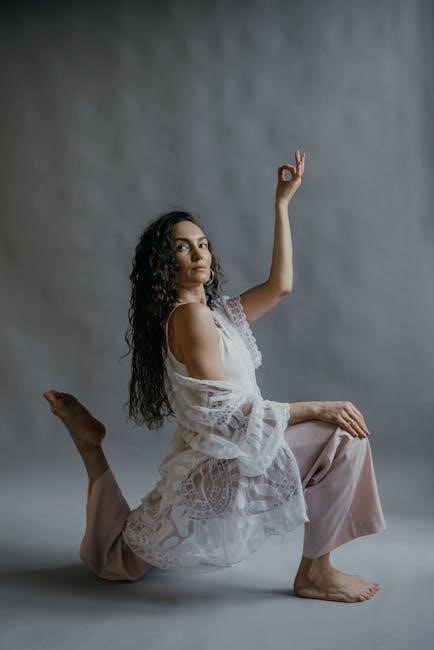
Correct Hand Position
The right hand rests gently on the left, palms upward, with thumbs touching to form a triangle. This gesture embodies balance and harmony, connecting to chakras and elements for deep meditation.
2.1 Thumb Placement and Finger Positioning
In Dhyana Mudra, the right hand is placed gently on the left, palms facing upward. The thumbs touch to form a triangle, symbolizing balance and harmony. Fingers remain extended but relaxed, with the right hand’s fingers resting lightly over the left. This placement connects to the heart chakra, promoting emotional and spiritual equilibrium. Proper alignment ensures energy flows freely, enhancing meditation depth and mindfulness.
2.2 Hand Placement in Different Meditation Postures
Dhyana Mudra can be practiced in various meditation postures, such as cross-legged sitting, lotus position, or even seated on a chair. The hands are placed in the lap, with the right hand resting gently on the left, palms upward. This placement remains consistent across postures, ensuring the mudra’s calming effects. Whether in Padmasana or Vajrasana, the focus is on maintaining a straight back and relaxed shoulders, allowing the mudra to enhance meditation depth and mindfulness.
Meaning and Symbolism
Dhyana Mudra symbolizes meditation, inner peace, and spiritual growth. It represents the union of opposites and connection to the five elements, fostering balance and harmony within.
3.1 Connection to Chakras and Elements
Dhyana Mudra connects to the heart chakra, symbolizing balance and harmony. The thumb represents fire, while the fingers embody earth, water, air, and ether. This union aligns energy, fostering equilibrium and spiritual growth. The gesture is believed to activate the third eye and crown chakras, enhancing intuition and higher consciousness. By linking the elements, it promotes holistic well-being and inner peace, making it a powerful tool for meditation and chakra alignment.
3.2 Spiritual and Philosophical Interpretations
Dhyana Mudra embodies the unity of the self with the universe, fostering a deep sense of inner peace and spiritual awakening. Rooted in Buddhist and yoga traditions, it symbolizes the harmony of opposites and the balance of masculine and feminine energies. The gesture is believed to quiet the mind, allowing practitioners to connect with their true nature and transcend worldly distractions. It represents the path to enlightenment and the cultivation of equanimity in meditation.

Benefits of Dhyana Mudra
Dhyana Mudra promotes deep relaxation, mental clarity, and spiritual growth. It enhances meditation by calming the mind, balancing energy, and fostering inner peace and equanimity.
4.1 Physical Benefits
Dhyana Mudra promotes physical relaxation by reducing muscle tension and improving circulation. It helps lower blood pressure, slows the heart rate, and enhances oxygen flow to the body. Regular practice can also alleviate chronic pain and stiffness, creating a sense of calm and balance. The mudra’s focus on proper posture and hand placement further supports spinal alignment, contributing to overall physical well-being and comfort during meditation.
4.2 Mental and Emotional Benefits
Dhyana Mudra cultivates mental clarity, calmness, and emotional balance. It reduces stress and anxiety by promoting deep relaxation and focus. Regular practice enhances concentration, memory, and emotional resilience. The mudra also helps in managing depression by fostering a sense of inner peace and stability. By quieting the mind, it supports emotional well-being and mental harmony, making it an effective tool for maintaining psychological health and overall life balance.
4.3 Spiritual Benefits
Dhyana Mudra promotes higher consciousness and inner peace, fostering a deeper connection to the universe. It enhances meditation by quieting the mind, allowing for greater focus on spiritual growth. This mudra is believed to awaken divine energy, aiding in self-realization and enlightenment. Regular practice strengthens intuition and spiritual awareness, helping practitioners align with their true nature and achieve a harmonious balance between body, mind, and spirit.
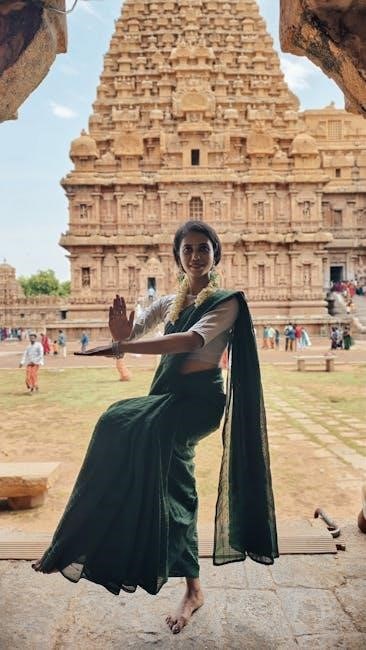
Steps to Practice Dhyana Mudra
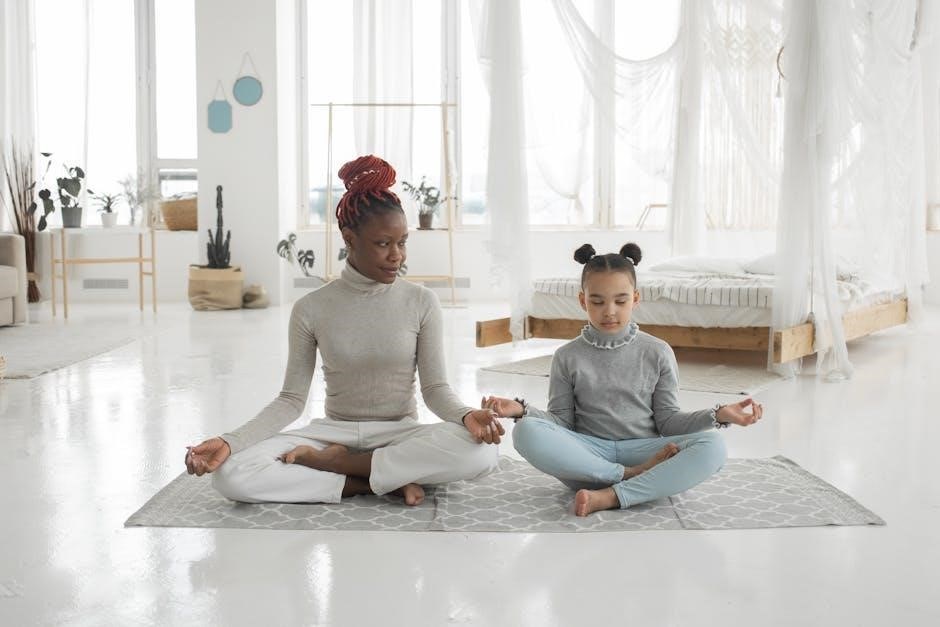
Sit comfortably, place your hands in your lap, and gently touch your thumbs together. Focus on your breath, fostering calmness and mindfulness during meditation.
5.1 Preparation and Posture
To practice Dhyana Mudra, sit comfortably in a meditative posture like Sukhasana or Padmasana. Keep your spine straight, shoulders relaxed, and hands placed gently in your lap. Ensure your posture promotes balance and stability, allowing deep breathing and focus. Proper alignment enhances the flow of energy, making it easier to maintain the mudra and enter a meditative state. Prepare your mind by setting an intention for calmness and mindfulness.
5.2 Detailed Practice Instructions
Begin by sitting in a comfortable meditative posture with your hands placed gently in your lap. Form Dhyana Mudra by placing your right hand on top of your left, palms upward, and touching the tips of your thumbs. This creates a triangle, symbolizing the connection between mind, body, and spirit. Close your eyes, focus on your breath, and maintain the mudra steadily. Practice for 10–15 minutes daily to enhance meditation depth and inner calm.
5.4 Tips for Effective Practice
For effective Dhyana Mudra practice, maintain correct posture and hand alignment. Use a cushion to support your meditation seat if needed. Begin with shorter sessions and gradually increase duration. Practice daily for consistency and deeper benefits. Utilize the PDF guide’s visual aids to ensure proper form. Combine the mudra with mindful breathing techniques for enhanced relaxation. Stay patient and relaxed, allowing the gesture to deepen your meditative state naturally.
Breathing Techniques
Breathing techniques enhance Dhyana Mudra’s effectiveness. Practice synchronized breath awareness with Pranayama, focusing on deep, steady inhales and exhales. This synchronization deepens meditation and relaxation, fostering inner calm and concentration.
6.1 Pranayama and Breath Awareness
Pranayama, the art of breath control, is essential for enhancing Dhyana Mudra’s benefits. Techniques like Ujjayi (ocean breath) and Nadi Shodhana (alternate nostril breathing) promote balance and calmness. By synchronizing breath with mudra, practitioners experience deeper relaxation and mental clarity. Awareness of each breath fosters mindfulness, allowing the mind to settle and connect with the present moment, amplifying the meditative state and spiritual connection.
6.2 Synchronized Breathing with Mudra
Synchronized breathing with Dhyana Mudra enhances its meditative effects. Practice breath awareness by focusing on the flow of air, ensuring it is steady and calm. Techniques like Ujjayi (ocean breath) or Nadi Shodhana (alternate nostril breathing) can be paired with the mudra to deepen relaxation. As breath and mudra align, energy flows harmoniously, fostering a balanced and centered state of mind, essential for meditation and spiritual growth.
Modifications and Variations
Dhyana Mudra can be adapted for different needs. Combining it with Abhaya Mudra enhances benefits, while variations like placing hands on knees suit mobility challenges, ensuring accessibility for all practitioners.
7.1 Adaptations for Different Needs
Dhyana Mudra can be adapted to suit various practitioners’ needs. For mobility challenges, hands can rest on knees or lap. Combining with Abhaya Mudra enhances relaxation. For smaller hands, fingers can lightly touch instead of fully interlocking. Wall support or cushions can aid posture. These modifications ensure accessibility, allowing everyone to benefit from the mudra’s calming effects and deep meditative state, fostering mindfulness and inner peace regardless of physical limitations or practice level.
7.2 Combining with Other Mudras
Dhyana Mudra can be paired with other mudras to enhance its benefits. Combining it with Abhaya Mudra fosters deep relaxation and inner peace, a common practice in Buddhist traditions. Additionally, pairing with Gyan Mudra can intensify focus and spiritual growth. These combinations amplify the meditative state, promoting mindfulness and emotional balance. Experimenting with different mudras allows practitioners to tailor their practice to specific goals, such as stress relief or heightened awareness, making meditation more effective and personalized.
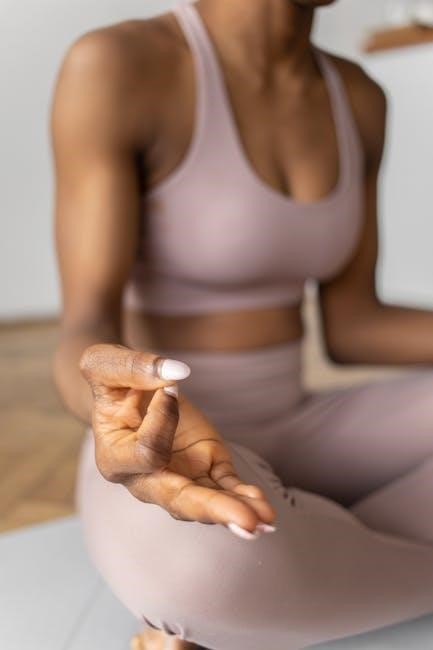
Safety and Precautions
Practice Dhyana Mudra gently to avoid hand or wrist strain. Ensure proper posture to prevent discomfort. Be mindful of joint limitations, especially for those with pre-existing conditions.
8.1 Contraindications
Individuals with severe wrist or joint pain should avoid Dhyana Mudra or modify it gently. Pregnant women and those with arthritis may need to adjust the hand placement. Children and people with recent injuries should practice cautiously. It is essential to consult a yoga expert if any discomfort arises during or after performing the mudra. Proper alignment and gentle practice are key to avoiding strain or injury.
8.2 Precautions for Beginners
Beginners should start slowly, ensuring gentle hand placement without forcing. Avoid tight grip or strain on wrists. Use cushions or supports for comfort. Focus on breath awareness to prevent overexertion. Start with short practice sessions and gradually increase duration. Seek guidance from an experienced instructor to avoid common mistakes. Prioritize relaxation and proper alignment to enjoy the benefits of Dhyana Mudra safely and effectively.

Yoga Sequences
Yoga sequences often integrate Dhyana Mudra with foundational asanas like Padmasana or Vajrasana, followed by meditation to enhance focus and calmness in a balanced practice.
9.1 Incorporating Dhyana Mudra into Yoga Practice
Dhyana Mudra is a powerful addition to yoga practice, enhancing focus and calmness. It is often combined with seated postures like Padmasana or Vajrasana. Begin by assuming a comfortable meditation seat, then form the mudra with hands resting in your lap. This integration promotes mindfulness and deep relaxation, making it ideal for ending a yoga sequence or transitioning into meditation. Regular practice fosters a balanced and centered state of being.
9.2 Recommended Asanas for Use with Dhyana Mudra
Padmasana (Lotus Pose) and Vajrasana (Thunderbolt Pose) are ideal for practicing Dhyana Mudra, as they support a straight spine and promote meditation. Sukhasana (Easy Pose) is also suitable, offering comfort for extended practice. These asanas help maintain proper posture, allowing the mudra to enhance focus and relaxation. Combining Dhyana Mudra with these seated postures creates a balanced and meditative state, deepening the overall yoga experience and fostering inner calm.
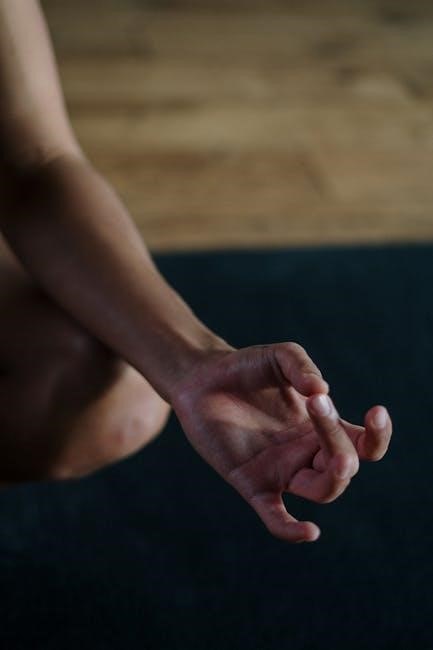
Common Mistakes
Common mistakes include incorrect thumb placement, excessive finger tension, and poor posture. Relaxation is key; avoid slouching and ensure gentle hand positioning for optimal benefits.
10.1 Avoiding Incorrect Hand Positions
Incorrect hand positions can hinder the effectiveness of Dhyana Mudra. Ensure the right hand rests gently in the left, with thumbs forming a triangle. Avoid tensing the fingers or wrists, as this disrupts the flow of energy. Proper alignment is crucial for maintaining balance and focus during meditation. Regular practice helps develop muscle memory, preventing common mistakes and enhancing the mudra’s benefits.
10.2 Overcoming Practice Challenges
Common challenges include maintaining hand positioning and focus. Start with shorter sessions and gradually increase duration. Use cushions for comfort and proper posture. Be patient with yourself, as consistency is key. Over time, the mind and body adapt, allowing for deeper meditation and inner calm. Embrace the journey, and remember, practice is the path to mastery.
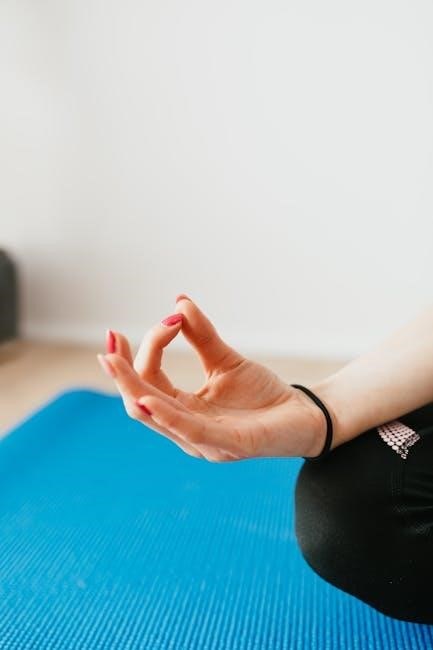
Cultural and Historical Context
Dhyana Mudra, rooted in Buddhist and yoga traditions, symbolizes meditation and inner peace. Historically used by monks and yogis, it fosters spiritual growth and mindfulness across generations.
11.1 Origins in Buddhist and Yoga Traditions
Dhyana Mudra originates from Buddhist and yoga traditions, where it is revered as a gesture of contemplation and inner balance. In Buddhism, it is often depicted in meditative postures of Buddha, symbolizing enlightenment and calmness. In yoga, this mudra is integral to Hatha Yoga practices, aiding in the union of body, mind, and spirit. Its historical roots emphasize its role in fostering mental clarity and emotional stability, making it a cornerstone of meditative practices across cultures.
11.2 Evolution and Modern Usage
Dhyana Mudra has evolved from ancient Buddhist and yogic practices into a widely recognized gesture for meditation and relaxation. Today, it is incorporated into modern yoga routines, mindfulness exercises, and holistic wellness practices. Its adaptability has made it accessible to diverse cultures, while retaining its core spiritual significance. Contemporary practitioners often combine it with breathing techniques and other mudras, such as Abhaya Mudra, to enhance its benefits. Its timeless appeal continues to inspire global adoption and innovation in meditative practices.
Conclusion
Dhyana Mudra is a powerful tool for meditation, promoting calmness and inner peace. Regular practice enhances mindfulness, connecting you to your spiritual core and fostering equanimity.
12.1 Summary of Key Points
Dhyana Mudra is a meditative hand gesture that promotes deep relaxation and inner peace. Correct formation involves specific thumb and finger placement, enhancing mindfulness and spiritual connection. Regular practice fosters mental clarity, emotional balance, and a sense of calm. Combining it with breathing techniques and other mudras amplifies its benefits. This mudra is a powerful tool for meditation, helping practitioners achieve equanimity and progress on their spiritual journey. Consistent practice is key to experiencing its profound effects.
12.2 Encouragement for Regular Practice
Embrace Dhyana Mudra as a daily practice to deepen your meditation and foster inner peace. Consistency will enhance its benefits, bringing calmness, focus, and spiritual growth. Even a few minutes each day can lead to profound progress. Combine it with mindful breathing and patience to fully experience its transformative power. Commit to regular practice and witness the positive changes it brings to your mental, emotional, and spiritual well-being over time.
Further Resources
Explore detailed guides, recommended readings, and online communities for deeper understanding. Utilize PDF resources and forums to enhance your Dhyana Mudra practice and knowledge effectively.
13.1 Recommended Reading and References
For in-depth understanding, explore books like “The Art of Mudras” and “Meditation and Mudras.” Online resources, such as detailed PDF guides, offer step-by-step instructions, images, and benefits. Websites specializing in yoga and meditation provide comprehensive manuals, ensuring clarity and effectiveness in practice. These references are essential for mastering Dhyana Mudra and integrating it into your daily routine for enhanced mindfulness and spiritual growth.
13.2 Online Communities and Forums
Engage with online communities like GitHub, where projects such as “free_chatgpt_api” and “ChatGPT-Jailbreak-Pro” offer insights and resources. Forums on platforms like Leboncoin and specialized yoga groups provide discussions, tutorials, and shared experiences. These spaces foster learning, troubleshooting, and inspiration, helping practitioners refine their Dhyana Mudra practice and connect with like-minded individuals globally.
Creating a PDF Guide
A comprehensive PDF guide on Dhyana Mudra includes high-quality images, detailed illustrations, and step-by-step instructions. It covers benefits, practice tips, and common mistakes for clarity and effectiveness.
14.1 Structure and Content
The PDF guide begins with an introduction to Dhyana Mudra, followed by detailed sections on its benefits, step-by-step practice instructions, and modifications. It includes high-quality images and diagrams to illustrate proper hand placement and posture. Additional sections cover breathing techniques, safety precautions, and common mistakes to avoid. The guide concludes with tips for effective practice and resources for further learning, ensuring a comprehensive and user-friendly experience for practitioners of all levels.
14.2 Visual Aids and Illustrations
The PDF guide includes high-quality images and detailed diagrams to visually demonstrate the correct formation of Dhyana Mudra. Illustrations of hand placement, thumb positioning, and proper posture provide clarity for practitioners. These visuals help users understand the nuances of the mudra, making it easier to practice correctly. The inclusion of step-by-step images ensures that even beginners can follow along with confidence, enhancing their learning experience and ensuring proper technique.

Sharing the Guide
Share the Dhyana Mudra guide through social media, yoga communities, and workshops. Engage with practitioners by discussing its benefits and encouraging feedback to foster a supportive community.
15.1 Distribution Channels
Share the Dhyana Mudra guide via social media platforms, yoga communities, and online forums. Use email newsletters and specialized groups to reach targeted audiences. Publish on websites, blogs, or platforms like Gumroad for wider accessibility. Engage with readers by adding links to your email signature or embedding the guide on your website. Participate in discussions to build a community and encourage feedback, fostering a supportive environment for practitioners to learn and grow together.
15.2 Engaging with the Community
Engage with the community by creating discussion threads in yoga and meditation forums. Share personal experiences and invite feedback to foster connection. Host webinars or Q&A sessions to address common questions. Encourage practitioners to share their journeys and tips, building a supportive network. Use social media groups to post updates and inspire others. Collaborate with influencers to reach a broader audience and create a sense of belonging among practitioners.


